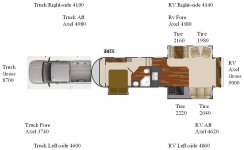Guys:
OK, we have come a long way in one day of discussion. I feel honored to have access to your opinions. Thanks for all the inputs.
Here are the major points I have noted so far:
1) Trailer tires should always be inflated to the maximum pressure listed on the tire sidewall
2) Any pressure less than the max on the sidewall is considered under inflated and risks a blowout from sidewall fatigue
3) Utilization excess loads need to be considered, highway slope, highway turns, low speed, large angle turning of tandom axel configuration, i.e. General Trailering
4) Higher pressures lead to less suspension movement and lower suspension wear over time
5) If trailer tire loads are to be measured, each tire needs to be measured individually to consider side to side load differences
I have been proposing that a better/safer condition might be to inflate tires based on their max expected load, plus some margin for variations. You load up your trailer and measure each wheel. There is plenty of support for setting vehicle tire pressures this way within the tire industry. I think my tire loads are significantly lower than my tire maximum load ratings, and a lower pressure is worth consideration. My tires are made in China and perhaps all margin is needed to cover that fact... Anyway, here is another significant source of tire information from the
RV Safety and Education Foundation. FYI.
 http://www.rvsafety.com/custompagedc2f.html?pg=weighingreport
http://www.rvsafety.com/custompagedc2f.html?pg=weighingreport
This article suggests measuring and using the tables for vehicles (motorhomes and trucks) and using tire side wall ratings for trailers, just as I've been told a couple times before. This fits with what GM said about their trucks. The exception for trailers is because of the excessive "squirming" trailer tires experience in turning they said, as also suggested by
KAKAMPERS, way to go. This is only one reference, but a pretty important one from relatively official RV industry folks.
Well, there's some supported rationale for max pressure tire inflation on a trailer, in addition to many identical inputs from just about everyone.

The only exception RSEF noted was when addressing a ride issue, which I was to some extent. I think I'll write to RSEF and get more information from them on 5th wheels in particular.
I'm going to weigh my trailer tomorrow anyway, just to see how much the side to side variation actually is, I'll let you know, FYI.
Any Additional Comments,
jim

